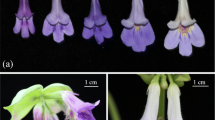Abstract
The first linkage map established by Lanaud et al. (1995) was used as a starting point to produce a high-density molecular linkage map. A mapping population of 181 progenies resulting from a cross between two heterozygous genotypes, a Forastero and a Trinitario (hybrid between Forastero and Criollo), was used for the linkage analysis. A new DNA isolation protocol was established, which allows enough good quality DNA to construct a genetic map with PCR-based markers. The map comprises 424 markers with an average spacing between markers of 2.1 cM. The marker types used were five isozymes, six loci from known function genes, 65 genomic RFLPs, 104 cDNA RFLPs, three telomeric probes, 30 RAPDs, 191 AFLPs and 20 microsatellites. The use of new marker types, AFLP and microsatellites, did not disturb the original order of the RFLP loci used on the previous map. The genetic markers were distributed over ten linkage groups and cover 885.4 cM. The maximum distance observed between adjacent markers was 16.2 cM, and 9.4% of all loci showed skewed segregation.
Similar content being viewed by others
Author information
Authors and Affiliations
Additional information
Received: 2 January 2000 / Accepted: 12 February 2000
Rights and permissions
About this article
Cite this article
Risterucci, A., Grivet, L., N’Goran, J. et al. A high-density linkage map of Theobroma cacao L.. Theor Appl Genet 101, 948–955 (2000). https://doi.org/10.1007/s001220051566
Issue Date:
DOI: https://doi.org/10.1007/s001220051566




